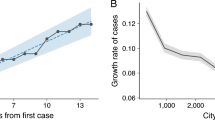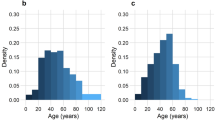Abstract
A surge in medical waste (MW) during the COVID-19 pandemic threatened environmental health globally. Learning from the experience of the COVID-19 pandemic can help governments to manage MW in the event of similar emergencies in the future. Here we compile a city-level dataset covering the MW generated during the COVID-19 pandemic and the capacity to dispose of it, and develop a model to estimate daily MW from respiratory diseases outbreaks from the test–isolation–treatment chain across 343 Chinese cities. The data collected allow the analysis of MW patterns related to COVID-19 restriction measures at different stages of the pandemic and enable the analysis of the sustainability of MW management. Our model estimates identify city-specific disposal optimization strategies for sustainable MW management. The dataset and the model presented here can support more in-depth research on MW management and aid policy makers dealing with the impacts of MW.
This is a preview of subscription content, access via your institution
Access options
Access Nature and 54 other Nature Portfolio journals
Get Nature+, our best-value online-access subscription
$32.99 / 30 days
cancel any time
Subscribe to this journal
Receive 12 digital issues and online access to articles
$119.00 per year
only $9.92 per issue
Buy this article
- Purchase on SpringerLink
- Instant access to full article PDF
Prices may be subject to local taxes which are calculated during checkout






Similar content being viewed by others
Data availability
The dataset on city-level MW management is available on GitHub at https://github.com/logiczhl/COVID-19-Medical-Waste-Dataset (ref. 41). Daily data were collected from the National Health Commission (http://www.nhc.gov.cn/xcs/yqtb/list_gzbd.shtml) and COVID-19 Time Series Infection Data Warehouse (https://github.com/BlankerL/DXY-COVID-19-Data). All versions of the pandemic prevention and control plan released by China are in Supplementary Table 5. The city-level disposal capacity optimization matrix during post pandemic is detailed in Supplementary Table 6. Source data are provided with this paper.
Code availability
The code is available on GitHub at https://github.com/logiczhl/CLACS (ref. 42).
References
World Health Organization. 14.9 million excess deaths associated with the COVID-19 pandemic in 2020 and 2021. News https://www.who.int/news/item/05-05-2022-14.9-million-excess-deaths-were-associated-with-the-covid-19-pandemic-in-2020-and-2021 (2022).
Pandemic’s plastic waste is choking the seas. Nature 599, 350 (2021).
Adyel, T. M. Accumulation of plastic waste during COVID-19. Science 369, 1314–1315 (2020).
Rahman, M. M., Bodrud-Doza, M., Griffiths, M. D. & Mamun, M. A. Biomedical waste amid COVID-19: perspectives from Bangladesh. Lancet Glob. Health 8, e1262 (2020).
Peng, Y., Wu, P., Schartup, A. T. & Zhang, Y. Plastic waste release caused by COVID-19 and its fate in the global ocean. Proc. Natl Acad. Sci. USA 118, e2111530118 (2021).
National Medical Waste Capacity Assessment COVID-19 Waste Management Factsheet 2 (United Nations Environment Program, 2020); https://wedocs.unep.org/handle/20.500.11822/32776
Office of the Seventh National Census Leading Group of the State Council. Data of Chinese population census by county in 2020 [in Chinese]. http://www.tjcn.org/tjnj/PCDC/40783.html (2022).
List of countries and dependencies by population. (Wikipedia, accessed 20 December 2024); https://en.wikipedia.org/wiki/List_of_countries_and_dependencies_by_population
Ding, Y., Zeng, Z., Zhang, X. & Chen, A. Quality requirements for the release of COVID-19 data and further regulatory suggestions. J. Data Sci. 18, 875–888 (2020).
Geng, M. et al. Changes in notifiable infectious disease incidence in China during the COVID-19 pandemic. Nat. Commun. 12, 6923 (2021).
Li, Z. et al. Etiological and epidemiological features of acute respiratory infections in China. Nat. Commun. 12, 5026 (2021).
Huang, Q. S. et al. Impact of the COVID-19 nonpharmaceutical interventions on influenza and other respiratory viral infections in New Zealand. Nat. Commun. 12, 1001 (2021).
Feng, L. et al. Impact of COVID-19 outbreaks and interventions on influenza in China and the United States. Nat. Commun. 12, 3249 (2021).
Dhanasekaran, V. et al. Human seasonal influenza under COVID-19 and the potential consequences of influenza lineage elimination. Nat. Commun. 13, 1721 (2022).
Wang, J. et al. Quantitative evaluation of infectious health care wastes from numbers of confirmed, suspected and out-patients during COVID-19 pandemic: a case study of Wuhan. Waste Manage. 126, 323–330 (2021).
Yang, L. et al. Emergency response to the explosive growth of health care wastes during COVID-19 pandemic in Wuhan, China. Resour. Conserv. Recycl. 164, 105074 (2021).
Chen, C. et al. What medical waste management system may cope with COVID-19 pandemic: lessons from Wuhan. Resour. Conserv. Recycl. 170, 105600 (2021).
Roberts, K. P. et al. Increased personal protective equipment litter as a result of COVID-19 measures. Nat. Sustain. 5, 272–279 (2022).
Singh, N., Tang, Y. & Ogunseitan, O. A. Environmentally sustainable management of used personal protective equipment. Environ. Sci. Technol. 54, 8500–8502 (2020).
Zhao, H. et al. Comparative life cycle assessment of emergency disposal scenarios for medical waste during the COVID-19 pandemic in China. Waste Manage. 126, 388–399 (2021).
Zhao, H. et al. Energy, environment and economy assessment of medical waste disposal technologies in China. Sci. Total Environ. 796, 148964 (2021).
Zhao, H. et al. A review on emergency disposal and management of medical waste during the COVID-19 pandemic in China. Sci. Total Environ. 810, 152302 (2022).
Hantoko, D. et al. Challenges and practices on waste management and disposal during COVID-19 pandemic. J. Environ. Manage. 286, 112140 (2021).
Liang, Y. et al. Repercussions of COVID-19 pandemic on solid waste generation and management strategies. Front. Env. Sci. Eng. 15, 115 (2021).
Ranjbari, M. et al. Mapping healthcare waste management research: past evolution, current challenges, and future perspectives towards a circular economy transition. J. Hazard. Mater. 422, 126724 (2022).
Rajak, R., Mahto, R. K., Prasad, J. & Chattopadhyay, A. Assessment of bio-medical waste before and during the emergency of novel coronavirus disease pandemic in India: a gap analysis. Waste Manage. Res. 40, 470–481 (2022).
Al-Omran, K., Khan, E., Ali, N. & Bilal, M. Estimation of COVID-19 generated medical waste in the Kingdom of Bahrain. Sci. Total Environ. 801, 149642 (2021).
Han, X. et al. SARS-CoV-2 nucleic acid testing is China’s key pillar of COVID-19 containment. Lancet 399, 1690–1691 (2022).
Cao, S. et al. Post-lockdown SARS-CoV-2 nucleic acid screening in nearly ten million residents of Wuhan, China. Nat. Commun. 11, 5917 (2020).
Li, Z. et al. Comprehensive large-scale nucleic acid-testing strategies support China’s sustained containment of COVID-19. Nat. Med. 27, 740–742 (2021).
Chinese nucleic acid detection ability: a strong guarantee for the realization of dynamic COVID-zero [in Chinese]. News http://www.news.cn/politics/2022-04/18/c_1128568895.htm (2022).
Liang, W. et al. The dynamic COVID‐zero strategy on prevention and control of COVID‐19 in China [in Chinese]. Natl Med. J. China 102, 239–242 (2022).
Statistical bulletin on the development of China’s health undertakings in 2020 [in Chinese]. (National Health Commission of the PRC, 2021); http://www.nhc.gov.cn/guihuaxxs/s10743/202107/af8a9c98453c4d9593e07895ae0493c8.shtml
National medical waste generation and disposal related to the situation to answer reporters [in Chinese]. (Ministry of Ecological Environment, 2022); https://www.mee.gov.cn/ywdt/zbft/202206/t20220629_987078.shtml
The second nucleic acid screening will be carried out in the sealed area! Shanghai latest bulletin [in Chinese]. CCTV News http://news.enorth.com.cn/system/2022/03/30/052486124.shtml (2022).
Focus on the end of COVID-19 prevention and control: start three emergency response, medical waste disposal capacity doubled [in Chinese]. (First Financial, 2022); https://finance.sina.com.cn/china/2022-04-22/doc-imcwipii5807876.shtml
Medical waste disposal in Wuhan undergone emergency tests [in Chinese]. The People’s Daily http://society.people.com.cn/n1/2020/0403/c1008-31659798.html (2020).
National Administration of Disease Control and Prevention. Vaccination of novel coronavirus [in Chinese]. (National Administration of Disease Control and Prevention, 2022); http://www.nhc.gov.cn/jkj/s7915/202206/412ec9bc37f946068cf983e460825777.shtml
Tonnes of COVID-19 health care waste expose urgent need to improve waste management systems. News (WHO, 2022); https://www.who.int/news/item/01-02-2022-tonnes-of-covid-19-health-care-waste-expose-urgent-need-to-improve-waste-management-systems
Ji, A. et al. Environmental and economic assessments of industry-level medical waste disposal technologies - a case study of ten Chinese megacities. Waste Manage. 174, 203–217 (2024).
Wen, Z., Zhao, H. & Zhang, Y. COVID-19-Medical-Waste-Dataset. GitHub https://github.com/logiczhl/COVID-19-Medical-Waste-Dataset (2025).
Wen, Z., Zhao, H. & Zhang, Y. Monte Carlo Simulation of the City-Level Surveillance-Chain Strategy. GitHub https://github.com/logiczhl/CLACS (2025).
Acknowledgements
We thank the Joint Scientific Research Fund of the National Natural Science Foundation of China (NSFC) and the Science and Technology Development Fund of Macao (FDCT) (72261160655), and the New Cornerstone Science Foundation through the XPLORER PRIZE; X. F. Wen from the Ministry of Ecology and Environment for providing valuable guidance; T. L. Chen at the Beijing Institute of Technology and W. H. Li at the China University of Petroleum for providing code assistance and comments; K. J. Lin at Tsinghua University, S. Q. Zhang, N. Li at Tianjin University, X. L. Ma at Zhengzhou University, J. H. Guan at Beijing University of Technology, Y. Liu at Xiamen University for data collection and collation; H. Q. Liu at Tianjin Chengjian University, Z. H. Liang, Y. H. Wang and Y. S. Feng at Tsinghua University for the revision of the manuscript.
Author information
Authors and Affiliations
Contributions
Z.W. and H.Z. co-designed the study. H.Z. contributed to data collection and process, conducted technical analyses and results interpretation, and wrote the paper. Z.W. supervised the research, conducted technical analyses and results interpretation, and revised the paper. Y.Z. participated in providing code assistance.
Corresponding author
Ethics declarations
Competing interests
The authors declare no competing interests.
Peer review
Peer review information
Nature Sustainability thanks Daniel Hoornweg and the other, anonymous, reviewer(s) for their contribution to the peer review of this work.
Additional information
Publisher’s note Springer Nature remains neutral with regard to jurisdictional claims in published maps and institutional affiliations.
Supplementary information
Supplementary information
Supplementary Figs. 1–3, Discussion and Tables 1–3.
Supplementary Table
Comparison of control measures for various types of people in multiple versions of COVID-19 prevention and control plan. City-level disposal capacity optimization matrix during post COVID-19. Key changes before and after COVID-19.
Source data
Source Data Fig. 2
City-level spatial and temporal distributions of large-scale nucleic acid test and CMW generation in China during the pandemic.
Source Data Fig. 3
Daily generation and percentage of CMW from treatment (local and imported infected cases) and isolation links.
Source Data Fig. 4
City-level spatial distribution of MW generation, disposal load rate, disposal capacity and their change rates in China.
Source Data Fig. 5
Changes in daily load rates and economic costs of national and city-level MW disposal facilities by optimizing the conventional capacity strategy and application phase, adjusting the pandemic prevention links and regions for emergency disposal facilities application.
Source Data Fig. 6
Probabilistic risk assessment of city-level surveillance-chain optimization strategies in various epidemic prevention and control for future early warning.
Rights and permissions
Springer Nature or its licensor (e.g. a society or other partner) holds exclusive rights to this article under a publishing agreement with the author(s) or other rightsholder(s); author self-archiving of the accepted manuscript version of this article is solely governed by the terms of such publishing agreement and applicable law.
About this article
Cite this article
Wen, Z., Zhao, H. & Zhang, Y. COVID-19 medical waste dataset and city-level disposal optimization strategies. Nat Sustain 8, 562–573 (2025). https://doi.org/10.1038/s41893-025-01550-8
Received:
Accepted:
Published:
Issue date:
DOI: https://doi.org/10.1038/s41893-025-01550-8
This article is cited by
-
The waste of COVID-19
Nature Sustainability (2025)



